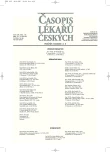-
Medical journals
- Career
Composition of the Nonesterified Fatty Acids and Lipid Peroxidation in Metabolic Syndrome
Authors: A. Žák 1; M. Vecka 1; E. Tvrzická 1,2; M. Jáchymová 2; M. Dušejovská 1; L. Janíková 1; B. Staňková 1; L. Vávrová 1; J. Kodydková 1; M. Zeman 1
Authors‘ workplace: IV. interní klinika 1. LF UK a VFN, Praha 1; Ústav klinické biochemie a laboratorní diagnostiky 1. LF UK a VFN, Praha 2
Published in: Čas. Lék. čes. 2007; 146: 484-491
Category: Original Article
Overview
Background.
Composition of the nonesterified fatty acids in plasma in metabolic syndrome patients and in other syndromes of insulin resistance is altered. Fatty acid profile in plasma is related to the composition of dietary fat and to the metabolic changes of fatty acids, e.g. to de novo lipogenesis, β-oxidation and conversion accompanying the oxidative stress. The aim of the work was to study the fatty acid composition in the major plasma lipid classes in relation to the insulin resistance, to some polymorphisms of candidate genes with activity related to insulin resistance, and to the lipoprotein composition and parameters of lipid peroxidation.Methods and Results.
95 patients with metabolic syndrome (56 M/39 F) and 195 healthy persons (99 M/96 F) were included into the cohort. Basic clinical data, parameters of glucose homeostasis, lipid concentration in plasma and conjugated diens in LDL were determined. Fatty acids were detected by capillary gas chromatography. Polymorphisms of apolipoprotein E, intestinal isoforms of fatty acid binding protein (Ala54Thr) and γ-2 isoforms of peroxisomal activated receptor (Ala12Pro) were analyzed using combination of polymerase chain reaction methods and by the detection of polymorphisms of the restriction fragment length. Persons with metabolic syndrome had higher concentrations of CRP and conjugated diens in LDL. In all lipid classes we proved a decreased concentration of n-6 polyunsaturated fatty acids and an increase of unsaturated fatty acids. From all the acids, the only significant was the decrease of linolic acid concentration and the increase of palmitic and palmitoyl acids. Results showed an increase of Δ9 palmitic acid desaturase activity, Δ6 linolic acid desaturase and elongase activity. Concentration of conjugated diens in LDL inversely correlated with linolic acid. Clinical or laboratory parameters and homozygotic combination of polymorphism studied were not mutually related.Conclusions.
Changes in the profile of fatty acids during the metabolic syndrome results from the elevated lipogenesis and from the higher level of oxidative stress.Key words:
metabolic syndrome, fatty acid composition, desaturase and elongase activity, oxidative stress, gene polymorphisms.
Labels
Addictology Allergology and clinical immunology Angiology Audiology Clinical biochemistry Dermatology & STDs Paediatric gastroenterology Paediatric surgery Paediatric cardiology Paediatric neurology Paediatric ENT Paediatric psychiatry Paediatric rheumatology Diabetology Pharmacy Vascular surgery Pain management Dental Hygienist
Article was published inJournal of Czech Physicians

-
All articles in this issue
- Bioequivalence Studies of Pharmaceutical Preparations
- Cognitive Functions Impairment in Diabetes Mellitus Patient
- Stem Cells, Stem Cell Therapy, and Ethical Problems of Medicine
- Present View on the Spinal Haemangioma
- Phototoxic Reaction After the Systemic Administration of Antimicrobial Drugs
- Problems of Regulation of Breathing
- Conjugated Linoleic Acid – The Dietary Supplement in the Prevention of Cardiovascular Diseases
- Transcription Factor Egr-1 in Cardiovascular Biology
- Incidence, Diagnostics and Therapy of the Lung Cancer in the Czech Republic in 2003
- Study of the Eosinophilic Inflammation Activity in Bronchial Asthma
- Composition of the Nonesterified Fatty Acids and Lipid Peroxidation in Metabolic Syndrome
- Prospects of Body Composition Analysis by Bioimpedance Method in Children
- The Assessment of Body Composition in Patients with Thyroid Dysfunction
- Is Prescription of Physical Activity a Part of Health Care in Civilization Disorders? Results of Questionnaire Study in Medical Doctors
- Stress Cardiomyopathy
- Journal of Czech Physicians
- Journal archive
- Current issue
- Online only
- About the journal
Most read in this issue- Bioequivalence Studies of Pharmaceutical Preparations
- Study of the Eosinophilic Inflammation Activity in Bronchial Asthma
- Stress Cardiomyopathy
- Prospects of Body Composition Analysis by Bioimpedance Method in Children
Login#ADS_BOTTOM_SCRIPTS#Forgotten passwordEnter the email address that you registered with. We will send you instructions on how to set a new password.
- Career

